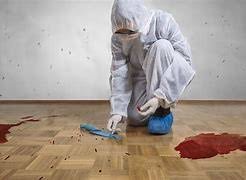Our Services
Bio-Hazard Cleaning
Crime scene cleaning, also known as trauma scene cleaning or bioremediation, involves the thorough decontamination and restoration of areas affected by biological hazards such as blood, bodily fluids, or other potentially infectious materials. These scenes often result from crimes, accidents, suicides, or unattended deaths. Below is a detailed description of the process and its components:
Key Aspects of Crime/Trauma Scene Remediation
Assessment:
Professionals inspect the scene to determine the extent of contamination.
Hazard evaluations include identifying bloodborne pathogens, structural damage, and odor sources.
Safety Measures:
Technicians wear Personal Protective Equipment (PPE), including gloves, goggles, masks, and biohazard suits.
Tools and cleaning agents are selected based on the type of contaminants present.
Containment:
Isolating the affected area prevents cross-contamination.
Cleaning and Sanitization:
Removal of all visible traces of blood, fluids, and organic matter using specialized chemicals and tools.
Surfaces are disinfected with hospital-grade or EPA-approved solutions.
Porous materials like carpets, mattresses or other furniture may need to be discarded if heavily contaminated.
Decontamination of Equipment:
Tools and reusable equipment are thoroughly sterilized after use to prevent further contamination.
Odor Neutralization:
Techniques like ozone treatment or the use of industrial-grade deodorants may be applied to eliminate lingering smells.
Waste Disposal:
All biohazardous waste is packaged and transported in compliance with local regulations for incineration or proper disposal.
Professional Qualifications
Crime scene cleaners are highly trained in biohazard remediation, disease control, and legal compliance.
Certification in areas such as OSHA Bloodborne Pathogens Standards and hazardous waste operations is often required.
Emotional Sensitivity
Professionals are trained to work discreetly and compassionately, recognizing the emotional toll such scenes have on victims' families and property owners.
When to Call a Professional
Crime scene cleaning is not suitable for untrained individuals due to health risks and legal considerations. Professionals are equipped to handle these situations safely and effectively, ensuring the area is fully sanitized and safe for reoccupation.
Septic leak remediation
Septic leak cleaning is a specialized process that involves identifying, containing, and addressing leaks or overflows from septic systems to prevent environmental contamination, health risks, and property damage. This process requires proper equipment, safety measures, and compliance with environmental regulations.
Key Aspects of Septic Leak Remediation
Assessment:
Professionals inspect the area to determine the extent of contamination.
Hazard evaluations include identifying structural damage, and odor sources.
Safety Measures:
Technicians wear Personal Protective Equipment (PPE), including gloves, goggles, masks, and biohazard suits.
Tools and cleaning agents are selected based on the type of materials to be cleaned and disinfected.
Containment:
Isolating the affected area prevents cross-contamination.
Cleaning and Sanitization:
Removal of all visible traces of waste using specialized chemicals and tools.
The surfaces are disinfected.
Porous materials like carpets, mattresses or other furniture may need to be discarded if heavily contaminated.
Decontamination of Equipment:
Tools and reusable equipment are thoroughly cleaned after use to prevent further contamination.
Odor Neutralization:
Techniques like ozone treatment or the use of industrial-grade deodorants may be applied to eliminate lingering smells.
Waste Disposal:
Collect all contaminated materials (soil, solids, absorbents, and cleaning supplies) and dispose of them following local environmental and hazardous waste regulations
When to Call Professionals
Cleaning up a septic leak is hazardous and may require professional help:
If the spill is extensive or reaches water sources.
If you cannot locate or stop the source of the leak.
To ensure compliance with environmental laws.
Septic cleanup specialists and environmental remediation services have the tools and expertise to handle these situations safely and effectively.
Hoarding clean up
Hoarding cleanup is a sensitive and intensive process that involves clearing, organizing, and sanitizing a space overwhelmed by excessive clutter. It can be emotionally and physically taxing, but with patience and a step-by-step approach, the space can be transformed into a safe and livable environment. This task requires a structured approach, emotional sensitivity, and often professional assistance.
Key Aspects of Hoarding Remediation
Assessment
Inspect the property to evaluate the extent of the hoarding and identify safety hazards like structural damage, pests, or mold.
Define what needs to be accomplished, such as clearing specific rooms or restoring functionality to certain areas.
Gloves, masks, heavy-duty garbage bags, cleaning solutions, a vacuum, and organizational tools like bins and labels.
Involve the Hoarder
Discuss the cleanup plan with the individual, emphasizing the benefits of a safer, healthier living environment.
Allow the hoarder to make decisions about sentimental items while guiding them toward practical choices.
Ensure the person agrees to the process to avoid causing distress or resistance.
Safety Measures
Technicians wear Personal Protective Equipment (PPE), including gloves, goggles, masks, and biohazard suits.
Tools and cleaning agents are selected based on the type of materials to be cleaned and disinfected.
Look for sharp objects, animal waste, mold, or unstable stacks of items.
Check plumbing, electricity, and gas lines to ensure they’re operational and safe.
Remove Trash and Clutter
Remove broken items, spoiled food, and irreparably damaged belongings.
Separate usable items like clothes, books, or furniture for donation centers.
Separate recyclable materials like paper, glass, and plastics for proper disposal.
Deep Clean the Space
Clean and disinfect floors, walls, countertops, and appliances.
Use air purifiers, deodorizers, or professional-grade odor neutralizers.
Address any infestations with professional exterminators if necessary.
When to hire a professional
For extensive hoarding situations or if biohazards are present, enlist a professional hoarding cleanup service. Professionals have the tools, training, and experience to handle challenging environments safely and efficiently.
Hoarding cleanup can be emotionally and physically taxing, but with patience and a step-by-step approach, the space can be transformed into a safe and livable environment.


